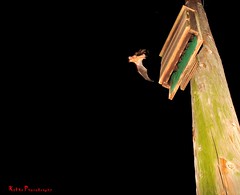I put out a call recently for good sources to aid in constructing myths & religion for invented worlds. This was inspired, among other things, by rereading the Earthsea books (backward starting from Tehanu — that experience may get its own post) and being impressed yet again with the density and richness of the world LeGuin created.
Malinda Lo suggested the author Katharine Briggs, whose life sounds as intriguing as her work on folklore. And there’s an award given in her honor! I plan to comb the list of winners.
Jeremy Antley recommended The Bathhouse at Midnight: An Historical Survey of Magic and Divination in Russia by W.F. Ryan (no relation that I know of) which I am excited to read. Although I confess I first scanned the title as The Bat House at Midnight and was a little disappointed to discover that it will not be about places like this:
And Lisa Blauersouth (who’s just started a blog on fairy tales and myths! Click, people!) commented: “Mostly I’ve spent years reading every myth and creation story i could get my grubby hands on, then looked for patterns. Creation stories tell you pretty much everything you need to know about a given religion/culture–the who, the what and the how.”
I think I’ll be rereading George Lakoff and Mark Johnson’s Metaphors We Live By, too.
More?


i don't mean to be a jerk but Sara
February 4, 2011 at 8:57 amTehanu isn’t the last book
Kip Manley
February 4, 2011 at 11:47 amLet me know if you want to borrow Bath House. —My other secret weapon (beyond all the magical and metamagical texts one might get one’s hands and eyes on) would be RPG supplements: pantheons and myths are generally presented in the sort of orderly logical manner that has nothing to do with the reality of the thing but is very helpful in sparking ideas for patterns of your own in laying this stuff out. —Anything that generates patterns, really: lay out some Tarot cards: don’t worry that you can’t read them; decide that each one’s a god, say, and where they fall on the table tells you relationships between them, and then let those kernels and the pictures start to tell you the story. Any pattern at all that you can hang your scraps of ideas on, and then start to obfuscate and complicate and tuck away and hide in the folds of the story.
Also: everything we do in this is made of nothing but words. So I love to take them apart, break them down, find out where they came from and build them up again in new and other directions. Dictionaries in other languages are wonderful for this. See what they called the planets, and how the kernels of meaning in those other words bounces off your own expectations; let those sparks illuminate the shapes of whatever it is in the dark you’re teasing out: another, weirder set of Tarot cards, that is. —And metaphors! And proverbs! And cliches! Take them literally, read them as stories in themselves, break them down, see where they came from, build them up again in otherly new directions and see where you end up…
Alain
February 4, 2011 at 4:14 pm“The Moon Moth” by Jack Vance, because this tiny short story is a masterful guide to juggling the sometimes distinct but sometimes united ideas of philosophy, political organisation, cultural values and social customs.
The punch line near the end, spoken by a Sirenese, starts to define the question “What is a religious belief”?
Sara
February 5, 2011 at 8:45 amCaleb: I learned that only after I’d finished rereading the first four. I should amend to all the Earthsea books that were in my house. Have you read the ones after Tehanu?
Kip: Glorious! So another way to look at this is that it’s about encouraging apophenia. (She says, always enjoying an excuse to use the word.)
Alain: Thanks! My dad loved Jack Vance, but I’ve read very little of his work so far. Will seek the story out!
Kip Manley
February 5, 2011 at 10:01 amApophenia, pareidolia, any of the mancies (skipping, perhaps, the ones that involve blood or entrails): whatever it takes to swing back and forth from déjà vu to jamais vu until you’re so dizzy you have no choice but break on through the presque vu to, well, whatever the hell it is, and bring back enough to dazzle without giving the game away. (One should note this general technique of course is useful for far more than demiurgic dramaturgy.)
still fruitlessly trying to hide my identity
February 7, 2011 at 1:01 pmyes, but only once each so far, but i’m building up to reading them again, but in the “right” order SILLY